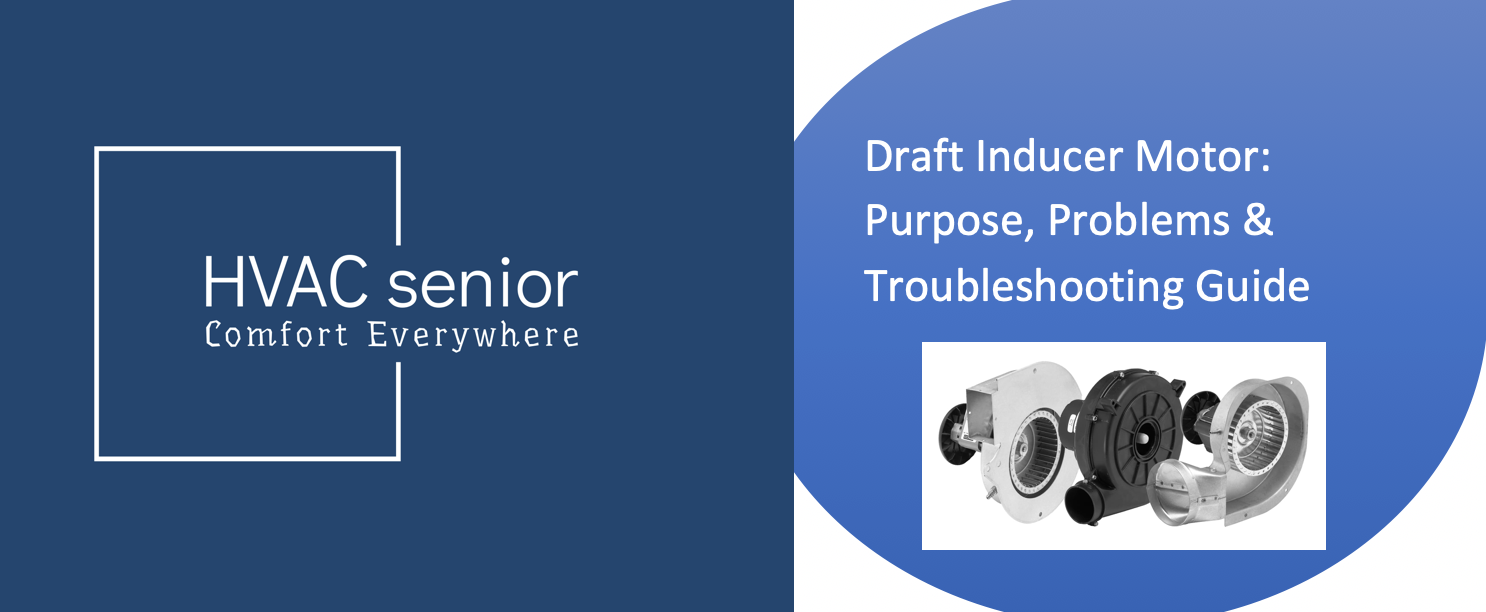When your furnace hums but doesn’t light, or you hear a strange whirring before startup, the problem could be with the draft inducer motor, one of the most important but overlooked pieces of a modern furnace.
This small motor-driven fan is critical to safe and efficient combustion. When it fails, your furnace may not light, might shut down unexpectedly, or perhaps even trigger safety lockouts.
In this detailed guide, we will be covering:
- What a draft inducer motor does
- How to spot signs of failure
- Troubleshooting steps
- Replacement and maintenance tips
What is a draft inducer motor?
Also known as the draft inducer blower, a draft inducer motor is a little fan that switches on at the start of each furnace heating cycle.
Its job is to clear out combustion gases from the previous cycle and pull in fresh air for safe and efficient ignition.
How It Works
- The control board starts the draft inducer motor when the thermostat calls for heat.
- This is accomplished by the negative pressure created by the motor’s fan, which draws air through the heat exchanger and out the flue pipe.
- This pressure is usually detected by the pressure switch; once verified, it tells the furnace to ignite the burners.
If the draft inducer motor fails or doesn’t create enough suction, a pressure switch remains open and prevents ignition.
Why the Draft Inducer Motor Matters
The draft inducer motor in modern furnaces increases both safety and efficiency:
- Safety: It ensures that toxic combustion gases, such as carbon monoxide, are vented outside.
- ⚙ Efficiency: Allows the creation of steady airflow for the complete combustion of fuels.
- Reliability: Sends the signal to the control board that it can safely ignite the gas.
Your furnace won’t be able to start without it; it’s part of the ignition sequence that keeps your system compliant with safety standards.
Also read: Frozen Heat Pump in Winter
Common Signs of a Faulty Draft Inducer Motor
Recognizing early symptoms can help you avoid a complete furnace shutdown.
1. Furnace Won’t Start
If the inducer motor doesn’t run, the pressure switch won’t close and it will stop ignition entirely.
Possible causes:
- Defective inducer motor
- Power supply malfunction
- Failed control board
2. Loud or Unusual Noise
Generally, a grinding, rattling, or squealing at startup is a good indication that the inducer motor is either worn out or failing.
Causes:
- Worn motor bearings
- Loose mounting bolts
- Cracked fan wheel
Solution: Tighten bolts, or if the noise persists, change the motor assembly.
3. Motor Runs Continuously
The inducer motor should stop once the heating cycle is over. If it continues to run:
- Pressure switch may be stuck closed.
- It may be that the control board is malfunctioning.
Check the pressure switch tubing for blockages and test continuity.
4. Furnace Short-Cycles
If your furnace turns on and off quickly, the inducer motor is having a hard time maintaining airflow – blockage or weak motor could be possible.
Corrected:
Check your fuel-burning equipment flue pipe and vent for blockages by bird nests, ice, or other debris.
5. Smell of Burning or Overheating Motor
Overheating usually occurs because of the bearings seizing up or when the fan wheel rubs against the housing.
Corrected:
Turn off the furnace immediately. An overheating motor can destroy the control board or wiring if further operation is allowed.
Also read: Furnace Short Cycling
Troubleshooting a Draft Inducer Motor
Here is a step-by-step process to diagnose a faulty inducer motor safely.
Step 1: Switch Off Power
Always shut off power to the furnace before any inspection to avoid electrical shock.
Step 2: Listen for Startup Sequence
The inducer motor should start first when the thermostat calls for heat.
If you don’t hear any sound, it’s time to start checking the voltage.
Step 3: Check Power Supply
Check for 120V (or 240V for your particular model) at the inducer motor terminals using a multimeter.
If there is no voltage, then the problem is with the control board or wiring.
If voltage is present but the motor doesn’t run, it is likely that the motor has burnt out.
Step 4: Testing the Pressure Switch
It is used with the draft inducer motor and pressure switch.
If, after the inducer has started, the pressure switch does not close, the furnace will shut down.
Corrections:
- Inspect the tubing for cracks, water, or dirt.
- Check that the vent pipe has no blockages.
- Check for continuity with a multimeter when suction is applied.
Step 5: Check for Mechanical Issues
- Spin the inducer fan manually; it should turn freely.
- Listen for scraping or grinding sounds.
- Remove dust or rust buildups on the blades.
Replacement is best if the motor shaft is stiff or seized.
Step 6: Inspect the Vent System
A partially blocked vent can cause high back pressure, straining the motor.
Clear blockages and obstructions; make sure snow or debris is not blocking the vent termination.
Replacing a Draft Inducer Motor
Thankfully, replacing your draft inducer motor is often relatively easy to do-if tests confirm that it is bad, that is-although some caution is required.
Tools Needed:
- Screwdriver set
- Multimeter
- Replacement inducer motor
- Gasket or sealant (if needed)
Replacement Steps:
- Shut off the power and gas supply.
- Disconnect wires from the old inducer motor. Label them first.
- Remove the mounting screws then gently disengage the assembly.
- Install new motor, using a new gasket for airtight sealing.
- Reconnect wiring and restore power.
- Perform a heat cycle to ensure that it starts up smoothly and quietly.
Pro Tip: Always replace the gasket whenever installing a new inducer motor to avoid exhaust leaks.
Also read: Furnace Blower Motor Not Working
Average Cost to Replace a Draft Inducer Motor
| Furnace Type | Typical Cost (USD) | Description |
| Standard Gas Furnace | $300 – $600 | Common single-stage motor replacement |
| High-Efficiency Furnace | $600 – $1,200 | Condensing models with sealed assemblies |
| DIY Replacement (part only) | $150 – $400 | For experienced homeowners |
Labor rates vary because of accessibility and the brand of the furnace. Inducers from manufacturers like Lennox, Carrier, Goodman, and Trane are set up differently.
Preventing Draft Inducer Motor Problems
Routine maintenance tends to go a long way in prolonging motor life.
1.Clean the furnace annually.
Dust accumulation on the motor and fan blades increases resistance, hence overheating.
2. Inspect Venting System
Check all outdoor vents during the fall and winter for nests, leaves, or ice.
⚙️ 3. Replace Filters Regularly
Dirty filters restrict airflow, forcing the inducer motor to work harder.
Electricity
4. Grease Bearings (where applicable)
Some older models have oil ports. Add a few drops of non-detergent motor oil once a year.
5. Plan for Professional Tune-ups
Test voltage, amp draw, and pressure switch performance with a certified HVAC technician to avoid premature motor failure.
Also read: Why is My Furnace So Loud
Safety Warning
Never attempt to lubricate or disassemble sealed inducer motors since most of them are not serviceable.
If you suspect electrical damage or smell burning, switch off the furnace immediately and call a licensed technician.
Always ensure that the connections of vents are tightly sealed after maintenance to avoid carbon monoxide leaks.
FAQs About Draft Inducer Motors
What happens if the draft inducer motor fails?
The pressure switch won’t close, so the furnace won’t ignite. The system could attempt ignition several times before it locks out.
How long does a draft inducer motor last?
Typically 10–15 years depending upon usage and maintenance. Heavy winter use or poor ventilation can shorten the lifespan.
Can I run my furnace without the inducer motor?
It is unsafe to bypass it; this may lead to carbon monoxide building up.
Is the inducer motor the same as the blower motor?
No, the inducer motor deals with exhaust gases whereas the blower motor circulates warm air through ducts.
Conclusion
The inducer motor in your furnace is the first component in every heating cycle, assuring that the venting of gases is proper and that ignition is dependable. When it fails, the whole system grinds to a halt.
Knowing how it works, spotting signs early, and doing some basic troubleshooting can save you time, money, and stress during cold seasons.
Watch for unusual noise, no ignition, or constant short-cycling, inspecting your inducer motor when necessary and scheduling a professional service to restore safe, quiet, and efficient operation.















